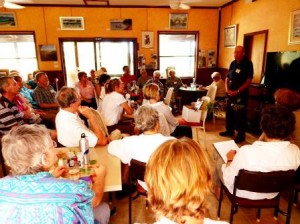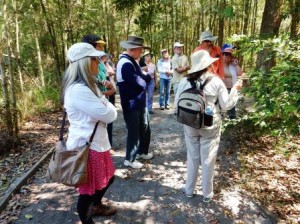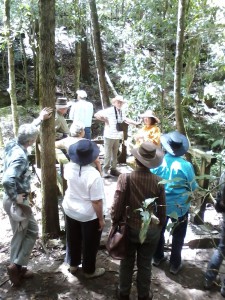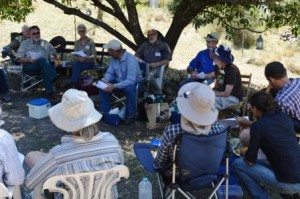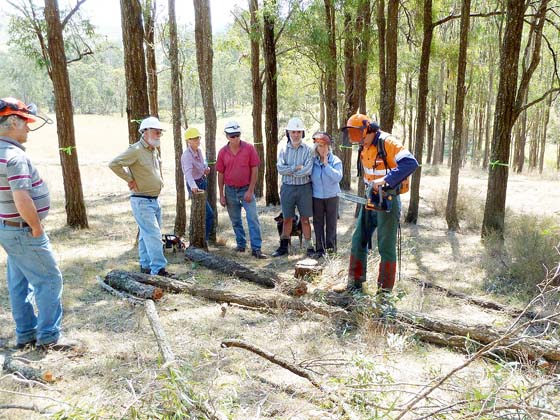Field Day November 2014
HFFN and the Hunter Local Land Services (HLLS) which provided funding had a very successful field day on tree planting led by Matt Kilby (Global Land Repair www.globallandrepair.com.au) and Noel Jupp (Riverdene Nursery www.riverdenenursery.com.au) demonstrating their proven methods. Forty five persons attended, undeterred by the heat, of which the majority were HFFN members. The field day was held at Wootton where HLLS is funding the plantation of thousands of trees with Noel providing the plants and Matt supervising the planting.
Some key points were: 6 months is required to prepare the land for planting by loosening the soil and removing weeds preferably without herbicide; the need to introduce fungi in the hole and not to fill the hole with water before planting; plants should be in a concave ditch that drains water to the root ball; a mat or compost/ wood chip is used to prevent the growth of weeds; the plants should be soaked in water for a week before planting and 20 litres poured on the plant when finished. If the weather is fine, it may not need further watering. Use a tree guard for the first 2 years.
The role of the mycorrhiza fungi and their interaction with plants can be read at http://www.cpbr.gov.au/fungi/mycorrhiza.html.
Noel said to improve soil he recommends that mulched and worm digested melaleuca styphelioides (prickly-leafed paper bark) is the very best but there is also a lack of these plants. Lantana, cabbages, ebony PR cow peas which can be planted and ploughed in in March before planting in April. Also, field lupins and he suggested planting pills which contain fertiliser and an insecticide and the use of blood and bone (the more odorous the better), to deter hares and wallabies.
An enjoyable lunch was provided by the Wootton Community Centre. Despite the high temperatures members felt a buzz of excitement learning from these 2 well known experts.
Matt with his hole digger preparing to plant Noel outlining his approach to growing seedlings
Field Day October 2014
The HFFN field day on 12th October was held at the Hunter Regional Botanic Gardens and attended by 22 members. Jenny, a volunteer with the Gardens, enthusiastically showed members around. We walked around many of the theme gardens, including a range of grevilleas and palms. Jenny revealed her vast knowledge of plants, birds and the environment to members with special emphasis on trees. The Blackbutts are native to the gardens and the planted flooded gums were also doing very well.
Lunch was provided by the Gardens staff and the AGM held afterwards with a new committee being elected. Minutes of the AGM have been circulated to members.
Jenny explaining aspects of the Gardens to members
Field Day August 2014
The weather forecast was not promising so planting by volunteers was cancelled, but surprisingly the day turned out fine and sunny. Members who took a chance on the weather enjoyed being shown around Ash Island by Rob Henderson from the Local Land Services.
We met in the old School Masters House which has been carefully restored. The Island has a mixture of areas: community gardens, cattle grazing, planting of eucalypts and even fruit trees. Restoration and preservation is the result of the work of volunteers and the CMA, now LLS. Rob finalised the visit with a BBQ at the Masters House.
Ash Island is named after the English Ash tree. We saw one of the few remaining trees and they are now being propagated. The other tree that used to be on the Island was red cedar but they were removed in the first twenty years of settlement.
The Island is now classified as a wetland of international importance.
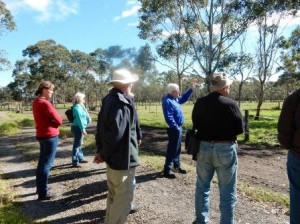 Rob discussing the plantation of six species of Eucalypti which have not grown very well
Rob discussing the plantation of six species of Eucalypti which have not grown very well
Field Day May 2014
The HFFN field day on 18th May was held at Chris and Ishbel Searle’s property at Howes Valley. From a site with initially only timber they have built their home, needing to use solar and rain water. They have a Private Native Forest agreement on their land and plan to manage the forest using silviculture principles.
As the property is surrounded by National Parks, preventing fires was of concern. Ken Ferguson from RFS and Keven Carter, an ex-forestry and National Parks employee spoke on the history and aims of low level burns, which had been recently carried out on the property. They emphasised the importance of back burning from the top of the hill down, and thinning the forest from the ground up. They named the five tree species known as The Royals in the forestry industry – ironbark, grey gum, turpentine, (all these grow in this area) tallow wood and white mahogany. These hardwoods were traditionally logged for railway sleepers and girders but are now in demand as high quality timber since the improvement in tools allows easier woodworking. Chris has too many Angophoras and is removing some to allow the Royals to take over.
Craig Tate, HFFN President and a forestry consultant, spoke about grants being available, particularly for forest corridors to be established and biodiversity in forested land.
A brief meeting moved and accepted the new constitution.
Field Day November 2013
For the final HFFN field day for 2013, fifteen members joined Patty and Karen who are involved in the management of the only significant rain forest near Sydney, the ‘Forest of Tranquillity’ at Ourimbah, for a walk through this magical place. The conditions were perfect in spite of the property receiving its largest rainfall in November. While everyone had their morning tea in a sheltered area, Patty alerted everyone to safety issues in the forest and a staff member gave an interesting talk about leeches. There are about 200 species of plants of which 50 are vines. A 5 km walk through the forest revealed extremely large and tall Sydney Blue Gums and Turpentine trees, rain forest trees and vines and a smaller area had mainly Bangalow Palms. The moisture content on the day was 90% – ideal for a rainforest along with creeks, a suitable soil and aspect.
A Private Vegetation Plan has been obtained, which ensures this unique place will be preserved.
Members thanked Patty and Karen for providing an insight into this forest, their future plans and sharing it.
A meeting was held during lunch time to discuss next year’s program, finalise the new constitution, collaborating with the Conservation Volunteers Australia and the ‘In Safe Hands Toolkit’ and general business.
Field day at Cootaame, Trevor Tops Rd and Upper Monkerai on 13th October 2013
Twenty three members and non-members gathered at two properties on a hot day to discuss appropriately hazard reduction. Kevin Carter, who had experience in National Parks, led the discussion. Hazard reduction is to preserve or protect assets such houses or buildings and includes keeping the property clear of vegetation through slashing. The direction and slope of the land will determine how many metres are required.
If there are more the 5 tons and less than 25 tons per hectare of under growth amongst trees, the fuel load, then a controlled burn may help. This requires advice from Rural Fire Service, notifying neighbours, ensuring the weather forecast is stable with temperature less than 25 degrees, humidity greater than 50%, and wind less than 15 km per hour, ensure easy access, that the controlled burning is contained and burn downhill. The leaf test can be used to measure humidity: leaf should burn when horizontal, but not when help upright.
Kevin also pointed out that there is a need to preserve trees with hollows, rain forest or riparian zones and some species do not resist fire (flooded gums). It is necessary to clear around these trees to ensure that they are safe. Smooth bark trees, white mahogany and iron bark are resistant to fire.
On inspecting the 2 properties, the first was well cleared, although from the West, the National Park over the road was the greatest threat. The second was also safe since the fuel load was low, and rain washes fallen leaves down into the creek.
With the problem of increasing and more severe fires this was a valuable education for members.
At lunch the AGM was held and Craig Tate accepted the position of President, and 2 new committee members were elected: Fred Fetherson and Nick Cameron. Below the new President addressing the members.
September 2012 field day
Eighteen HFFN members and friends attended the regrowth management field day at the 640 acre grazing property at Mirannie. Tree types scattered throughout the property include spotted gum, bluegum, redgum. yellow box, grey box and narrow leaf ironbark. A stand of post 1990 regrowth trees, consisting almost entirely of narrow leaf ironbark was inspected and trees for retention were marked with tape. Criteria for retention included biodiversity, dominance, form, edge trees, mature seed source, potential posts and interestingly dead small trees that will fall of their own accord. Some of the trees for retention were pruned using a pole saw and electric clippers on pole, the latter capable of the neater job. Some of the remaining trees were felled by chainsaw. The front wedge cut – bottom cut horizontal and in about one quarter of the diameter and the top cut angled at about 30 degrees; the back horizontal cut slightly above the front horizontal cut; and the resulting hinge of width about 15% of diameter were demonstrated. The final felling act was either pulling from a safe distance by previously attached rope and or by inserting a wedge in the back cut. It was stressed that those planning on felling trees should first attend a reputable course. An electrical chainsaw was used for removing branches quickly from the felled trees. Stumps were then cut off close to ground level to reduce obstacles to later traffic. Any stumps to be left to coppice should be cut horizontal on top about a diameter height above ground level. This was a most informative and enjoyable day.

